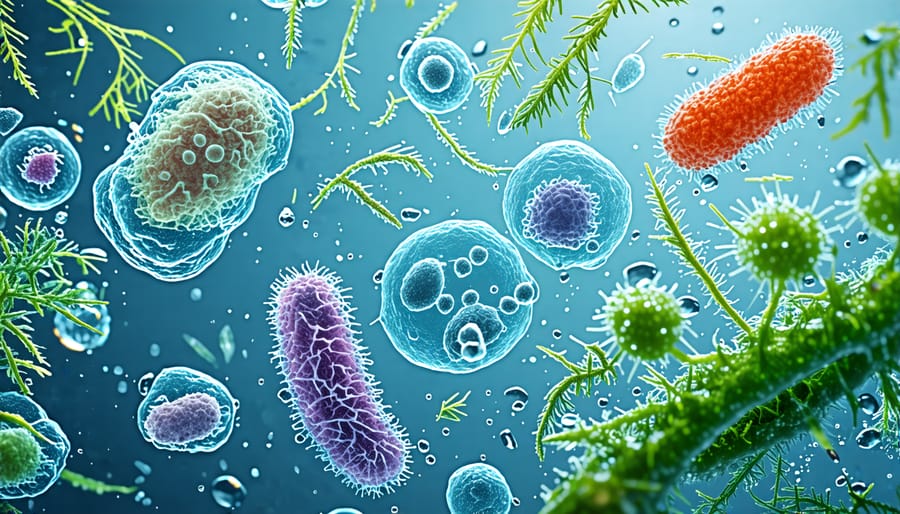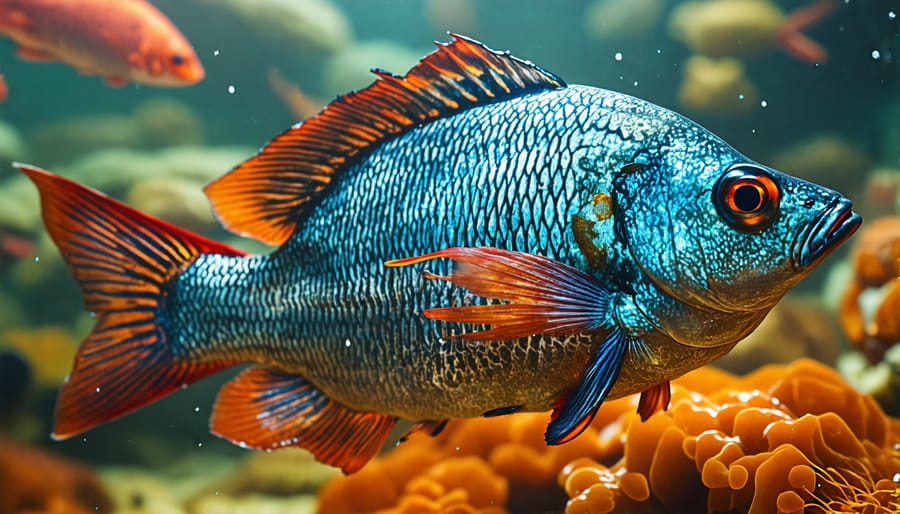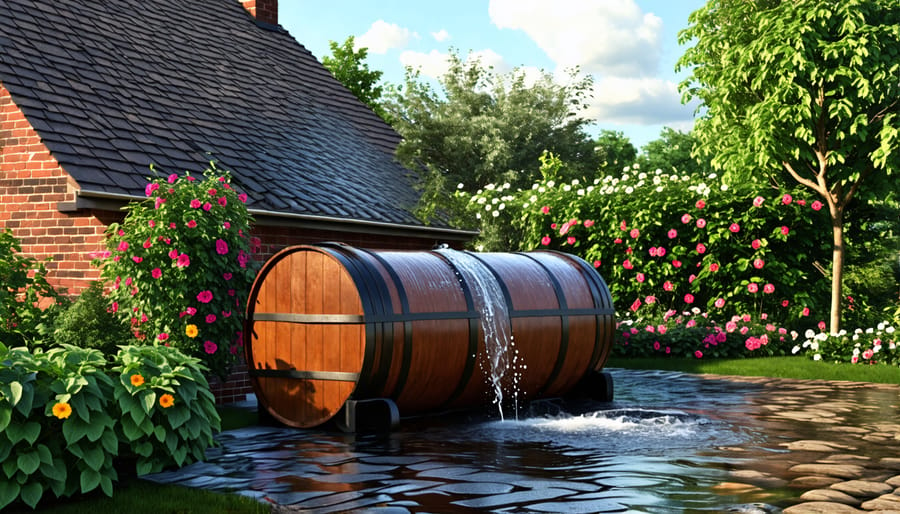
The Perils and Possibilities of Adding Pond Water to Your Aquarium
Carefully consider the risks before adding pond water to your aquarium. Pond water may contain harmful bacteria, parasites, or chemicals that can threaten your fish. Quarantine any fish, plants, or decorations from the pond for at least 2 weeks before introducing them to your main tank. Treat the pond water by filtering it through activated carbon or UV sterilization to remove potential pathogens. Monitor ammonia, nitrite, and pH levels closely after adding pond water and be prepared for more frequent water changes. An indoor water garden with separate filtration is a safer way to enjoy pond elements without risking your main aquarium inhabitants.
The Potential Benefits of Pond Water
Beneficial Bacteria and Microorganisms
Pond water is teeming with beneficial bacteria and microorganisms that can give your aquarium a helpful boost. These microscopic allies play a crucial role in establishing and maintaining a healthy nitrogen cycle, which is essential for the well-being of your aquatic pets. When you introduce pond water to your tank, you’re not just adding water – you’re seeding it with a diverse array of bacteria that can jumpstart the biological filtration process.
These beneficial bacteria, such as Nitrosomonas and Nitrobacter, work tirelessly to break down ammonia and nitrites, which are toxic to fish, into less harmful nitrates. This natural cycle helps keep your water quality in check and creates a more stable environment for your aquatic critters. Plus, the microorganisms in pond water can also help decompose organic matter, reducing the build-up of sludge and debris in your tank.
It’s like giving your aquarium a probiotic supplement, promoting a thriving ecosystem where your fish and plants can flourish. And if you’re interested in taking your aquatic adventures to the next level, consider setting up an aquaponics system, where the beneficial bacteria from pond water can work wonders in creating a self-sustaining, symbiotic environment for both your fish and your plants.

Natural Nutrients and Minerals
Pond water can be a natural source of trace nutrients and minerals that may benefit aquarium plants and fish. Depending on the pond’s ecosystem, the water might contain dissolved organic compounds, nitrogen, phosphorus, potassium, and other micronutrients. These aquarium nutrients are essential for plant growth and can supplement commercial fertilizers. The diverse microbial life in pond water could also contribute to a healthy nitrogen cycle in the aquarium. However, it’s crucial to test the pond water first to ensure it’s safe and suitable for your aquatic pets, as excessive nutrients can lead to algae blooms and water quality issues.
The Risks of Using Untreated Pond Water

Parasites and Disease
Adding pond water to your aquarium can introduce a variety of harmful parasites, bacteria, and other pathogens that can seriously impact the health of your fish. Common parasites found in pond water include ich (Ichthyophthirius multifiliis), flukes, and anchor worms. These parasites can attach to the skin, gills, or internal organs of fish, causing irritation, respiratory problems, and potentially fatal infections.
Bacterial diseases like fin rot, columnaris, and fish tuberculosis can also be introduced through pond water. These infections can lead to frayed fins, ulcers, lethargy, and death if left untreated. Viral diseases such as koi herpes virus and spring viremia of carp are highly contagious and can quickly spread throughout an aquarium, causing severe losses.
Other pathogens like fungal infections and water molds can also be present in pond water. These can cause cotton-like growths on fish, damaging their skin and leading to secondary bacterial infections. Protozoal parasites such as Trichodina and Chilodonella can cause skin irritation and respiratory distress in fish.
It’s crucial to remember that even if pond fish appear healthy, they may still carry these pathogens without showing obvious signs of disease. When introduced to the confined environment of an aquarium, these pathogens can quickly multiply and infect your fish. Quarantining new fish and practicing proper aquarium maintenance are essential steps in preventing the spread of disease. If you suspect your fish may be infected, consult a veterinarian specializing in fish care for proper diagnosis and treatment options.
Chemical Contaminants
Pond water may contain various chemical contaminants, especially if the pond is located in an urban or agricultural area. Pollutants such as pesticides, herbicides, and fertilizers can easily find their way into pond water through runoff from nearby lawns, gardens, or farms. These harmful chemicals can be toxic to fish and other aquatic life, causing stress, disease, or even death. Industrial pollutants like heavy metals and petroleum products may also be present in pond water, particularly if the pond is near a busy road or factory. These contaminants can accumulate in the tissues of fish and invertebrates, leading to long-term health issues. Before adding pond water to your aquarium, it’s crucial to test for the presence of these harmful substances using specialized water testing kits. If high levels of pollutants are detected, it’s best to avoid using the pond water altogether and opt for a safer alternative.
Safer Alternatives to Untreated Pond Water
Collecting and Aging Rainwater
If you’re hesitant about using pond water directly in your aquarium, collecting rainwater can be a safer alternative. Rainwater is naturally soft and free from many of the contaminants and organisms found in ponds. It’s an excellent choice for topping off your aquarium or performing water changes. To collect rainwater, set up a clean barrel or container in an open area away from trees and debris. Cover the container with a fine mesh screen to keep out insects and fallen leaves. Once you’ve collected enough rainwater, it’s important to let it age before adding it to your aquarium. Aging allows any dissolved gases to escape and stabilizes the pH. Store the collected rainwater in a cool, dark place for at least a week. You can aerate the water using an air stone to speed up the aging process. Before using the aged rainwater in your aquarium, test it for pH, ammonia, nitrite, and nitrate levels to ensure it’s safe for your fish. While rainwater isn’t a perfect match for the complex ecosystem of pond water, it can be a reliable and low-risk option for maintaining your aquarium’s water quality.

Treating Pond Water Before Use
If you’re determined to use pond water in your aquarium, it’s crucial to properly treat it before adding it to your tank. Start by testing the pond water for pH, ammonia, nitrite, and nitrate levels to ensure they are within safe ranges for your aquatic inhabitants. Next, consider filtering the pond water through a fine mesh or a dedicated pond filter to remove debris, organic matter, and potential pathogens. You may also want to let the filtered water sit in a separate container for a day or two to allow any suspended particles to settle. As an extra precaution, you can quarantine the pond water in a separate tank for a week or more to monitor for any signs of disease or water quality issues before slowly introducing it to your main aquarium. Remember, patience and diligence are key when using pond water to ensure the health and safety of your aquatic pets.
Conclusion
In summary, while adding pond water to your aquarium may seem like a natural and cost-effective solution, it’s crucial to weigh the potential benefits against the significant risks. Pond water can introduce harmful pathogens, parasites, and contaminants that could jeopardize the health of your aquatic pets. Additionally, the chemical composition and nutrient levels in pond water are often incompatible with the delicate balance required in an aquarium environment.
However, if you’re still drawn to the idea of incorporating natural elements into your aquarium, there are safer alternatives to explore. Consider using driftwood, rocks, or plants sourced from reputable aquarium suppliers to enhance the aesthetics of your tank without compromising its stability. You can also create a separate backyard pond to enjoy the beauty of natural water features while maintaining the integrity of your indoor aquarium.
Before making any decisions about adding pond water to your aquarium, it’s essential to conduct thorough research and consult with experienced aquarists or professionals in the field. By understanding the complexities involved and prioritizing the well-being of your aquatic pets, you can make informed choices that will lead to a thriving and vibrant aquarium ecosystem.
